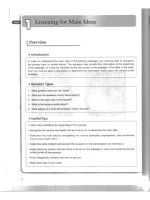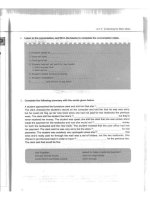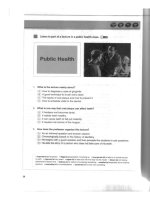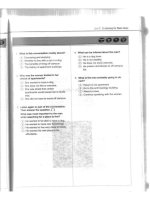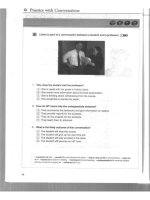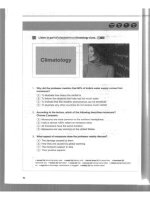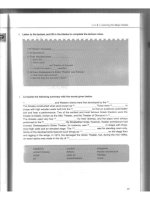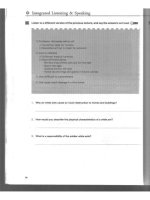Ebook Fundamentals of case management practice - Skills for the human services (4th edition): Part 1
Bạn đang xem bản rút gọn của tài liệu. Xem và tải ngay bản đầy đủ của tài liệu tại đây (2.64 MB, 204 trang )
www.downloadslide.com
www.downloadslide.com
This is an electronic version of the print textbook. Due to electronic rights restrictions, some third party content may be suppressed.
Editorial review has deemed that any suppressed content does not materially affect the overall learning experience.
The publisher reserves the right to remove content from this title at any time if subsequent rights restrictions require it.
For valuable information on pricing, previous editions, changes to current editions, and alternate formats,
please visit www.cengage.com/highered to search by ISBN#, author, title, or keyword for materials in your areas of interest.
www.downloadslide.com
FOURTH EDITION
FUNDAMENTALS OF
Case Management
Practice
Skills for the Human Services
Nancy Summers
Harrisburg Area Community College
Australia • Brazil • Japan • Korea • Mexico • Singapore • Spain • United Kingdom • United States
www.downloadslide.com
Fundamentals of Case Management
Practice, Skills for the Human Services,
Fourth edition
Nancy Summers
Publisher/Executive Editor:
Linda Schreiber-Ganster
Acquisitions Editor: Seth Dobrin
© 2012, 2009, 2006 Brooks/Cole, Cengage Learning
ALL RIGHTS RESERVED. No part of this work covered by the copyright herein
may be reproduced, transmitted, stored or used in any form or by any means
graphic, electronic, or mechanical, including but not limited to photocopying,
recording, scanning, digitizing, taping, Web distribution, information networks,
or information storage and retrieval systems, except as permitted under
Section 107 or 108 of the 1976 United States Copyright Act, without the prior
written permission of the publisher.
Assistant Editor: Naomi Dreyer
Editorial Assistant: Suzanna Kincaid
Technology Project Manager: Elizabeth Momb
Marketing Manager: Christine Sosa
Marketing Coordinator: Gurpreet Saran
Marketing Communications Manager:
Tami Strang
For product information and technology assistance, contact us at
Cengage Learning Customer & Sales Support, 1-800-354-9706
For permission to use material from this text or product,
submit all requests online at cengage.com/permissions
Further permissions questions can be emailed to
Senior Art Director: Jennifer Wahi
Library of Congress Control Number: 2011924386
Print Buyer: Rebecca Cross
ISBN-13: 978-0-8400-3369-7
Rights Acquisition Specialist (Text):
Isabel Saraiva
ISBN-10: 0-8400-3369-9
Cover Designer: The Resource Agency
Cover Image: Getty Images
Production Service: PreMediaGlobal
Content Project Management: PreMediaGlobal
Brooks/Cole
10 Davis Drive
Belmont, CA 94002-3098
USA
Cengage Learning is a leading provider of customized learning solutions with
office locations around the globe, including Singapore, the United Kingdom,
Australia, Mexico, Brazil, and Japan. Locate your local office at:
international.cengage.com/region
Cengage Learning products are represented in Canada by Nelson Education, Ltd.
For your course and learning solutions, visit academic.cengage.com
Purchase any of our products at your local college store or at our preferred
online store www.cengagebrain.com
Printed in the United States of America
1 2 3 4 5 6 7 15 14 13 12 11
www.downloadslide.com
To my parents, whose humor and wisdom about people and relationships
formed the foundation for my work with others
www.downloadslide.com
Contents
Preface
Section 1
xiii
Foundations for Best Practice
in Case Management
Chapter 1
Ethics and Other Professional Responsibilities for
Human Service Workers
1
Introduction
1
Language and Ethics
2
Dual Relationships
2
Value Conflicts
6
The Rights of Individuals Receiving Services
10
Confidentiality
13
Privacy
17
Health Insurance Portability and Accountability Act
17
Social Networking
20
Privileged Communication
21
When You Can Give Information
21
Diagnostic Labeling
24
Involuntary Commitment
25
Ethical Responsibilities
26
Protecting a Person’s Self-Esteem
27
Stealing from Clients
29
Competence
30
Responsibility to Your Colleagues and the Profession
31
Professional Responsibility
33
Summary
34
Talk it Over
34
Exercises I: Ethics
34
Exercises II: Ethically, What Went Wrong?
37
Exercises III: Decide on the Best Course of Action
41
Exercises IV: What is Wrong Here?
42
Chapter 2 Case Management: Definition and Responsibilities
Introduction
43
A History of Case Management
44
Why We Use Case Management
44
Assessment
45
Planning
46
Creating an Individualized Plan
49
Linking
52
iv
Contents
43
www.downloadslide.com
Monitoring
53
Advocacy
53
Service Coordination
55
Levels of Case Management
57
Separating Case Management from Therapy
59
Case Management in Provider Agencies
60
Managed Care and Case Management
61
Underlying Principles: Hope and Self-Determination
63
Generic Case Management
65
Summary
65
Exercises I: Case Management
66
Exercises II: Decide on the Best Course of Action
69
Chapter 3
Applying the Ecological Model: A Theoretical Foundation
for Human Services
71
Introduction
71
Seeking a Balanced View of the Client
72
The Three Levels
74
Looking at What the Person Brings
74
Looking at What the Context Brings
75
Developmental Transitions
76
Developing the Interventions
77
Working with the Generalist Approach
78
Macro Level Interventions are Advocacy
79
Summary
79
Exercises I: Looking at Florence’s Problem on Three Levels
80
Exercises II: Designing Three Levels of Intervention
81
Section 2
Useful Clarifications and Attitudes
Chapter 4 Cultural Competence
85
Introduction
85
Culture and Communication
85
Your Ethical Responsibility
86
Where Are the Differences?
86
Strangers
88
Anxiety and Uncertainty
89
Thoughtless versus Thoughtful Communication
Dimensions of Culture
94
Obstacles to Understanding
99
Competence
101
Summary
102
Exercises I: Testing Your Cultural Competence
90
103
Chapter 5 Attitudes and Boundaries
107
Introduction
107
Understanding Attitudes
107
Basic Helping Attitudes
108
Reality Check
111
How Clients Are Discouraged
111
Understanding Boundaries
114
Contents
v
www.downloadslide.com
Seeing Yourself and the Client as Completely Separate
Individuals
114
Erecting Detrimental Boundaries
116
Transference and Countertransference
116
Summary
117
Exercises I: Demonstrating Warmth, Genuineness, and
Empathy
118
Exercises II: Recognizing the Difference—Encouragement or
Discouragement
123
Exercises III: Blurred Boundaries
124
Chapter 6 Clarifying Who Owns the Problem
127
Introduction
127
If the Client Owns the Problem
128
If You Own the Problem
131
If You Both Own the Problem
131
Summary
132
Exercises I: Who Owns the Problem?
133
Exercises II: Making the Strategic Decision
135
Section 3
Effective Communication
Chapter 7 Identifying Good Responses and Poor Responses
Introduction
137
Twelve Roadblocks to Communication
138
Useful Responses
142
Summary
150
Exercises: Identifying Roadblocks
150
Chapter 8 Listening and Responding
153
Introduction
153
Defining Reflective Listening
154
Responding to Feelings
154
Responding to Content
158
Positive Reasons for Reflective Listening
160
Points to Remember
160
Summary
162
Exercises I: How Many Feelings Can You Name?
Exercises II: Finding the Right Feeling
162
Exercises III: Reflective Listening
163
Chapter 9 Asking Questions
169
Introduction
169
When Questions Are Important
170
Closed Questions
170
Open Questions
171
Questions That Make the Client Feel
Uncomfortable
172
A Formula for Asking Open Questions
vi
Contents
173
162
137
www.downloadslide.com
Summary
175
Exercises I: What Is Wrong with These
Questions?
176
Exercises II: Which Question Is Better?
178
Exercises III: Opening Closed Questions
179
Exercises IV: Try Asking Questions
181
Chapter 10 Bringing Up Difficult Issues
183
Introduction
183
When to Use Confrontation
184
The I-Message in Confrontation
185
Asking Permission to Share Ideas
190
Advocacy: Confronting Collaterals
190
On Not Becoming Overbearing
191
Summary
193
Exercises I: What Is Wrong Here?
193
Exercises II: Expressing Your Concern
195
Exercises III: Expressing a Stronger Message
197
Chapter 11 Addressing and Disarming Anger
199
Introduction
199
Common Reasons for Anger
199
Why Disarming Anger Is Important
200
Avoiding the Number-One Mistake
201
Erroneous Expectations for Perfect Communication:
Another Reality Check
202
The Four-Step Process
203
What You Do Not Want to Do
205
Look for Useful Information
207
Managing an Angry Outburst
207
Summary
208
Exercises I: Initial Responses to Anger
209
Exercises II: Practicing Disarming
209
Chapter 12 The Effective Combination of Skills
211
Introduction
211
Combining Skills and Attitudes
212
Communication Skills That Facilitate Change
213
Trapping the Client
218
From Adversarial to Collaborative
219
Case Manager Traps
221
Summary
224
Chapter 13 Putting It All Together: Exercises
Introduction
227
Exercise I
227
Exercise II
228
Exercise III
231
Exercise IV
233
Exercise V
235
227
Contents
vii
www.downloadslide.com
Section 4
Meeting Clients and Assessing Their Strengths
and Needs
Chapter 14 Documenting Initial Inquiries
237
Introduction
237
Guidelines for Filling Out Forms
238
Steps for Filling Out the New Referral or Inquiry Form
Evaluating the Client’s Motivation and Mood
240
Steps for Preparing the Verification of Appointment Form
Summary
243
Exercises I: Intake of a Middle-Aged Adult
243
Exercises II: Intake of a Child
244
Exercises III: Intake of an Infirm, Older Person
244
Chapter 15 The First Interview
245
Introduction
245
Your Role
246
The Client’s Understanding
246
Preparing for the First Interview
246
Your Office
247
Meeting the Client
248
Summary
252
Chapter 16 Social Histories and Assessment Forms
253
Introduction
253
What Is a Social History?
254
Layout of the Social History
254
How to Ask What You Need to Know
255
Who Took the Social History
262
Social Histories in Other Settings
266
Writing Brief Social Histories
266
Using an Assessment Form
270
Taking Social Histories on a Computer
271
The Next Step
272
Summary
272
Exercises I: Practice with Social Histories
273
Exercises II: Assessment of a Middle-Aged Adult
273
Exercises III: Assessment of a Child
274
Exercises IV: Assessment of an Infirm, Older Person
274
Exercises V: Creating a File
275
Chapter 17 Using the DSM
277
Introduction
277
Is DSM Only a Mental Health Tool?
Cautions
278
Who Makes the Diagnosis?
279
Background Information
279
Using the DSM
283
Making the Code
288
Additional Information
290
Summary
291
Exercises: Using the DSM
291
viii
Contents
278
238
242
www.downloadslide.com
Chapter 18 The Mental Status Examination
295
Introduction
295
Observing the Client
296
Mental Status Examination Outline
297
Summary
314
Exercises: Using the MSE Vocabulary
314
Chapter 19 Receiving and Releasing Information
317
Introduction
317
Sending for Information
317
If You Release Information
317
Directions for Using Release Forms
318
Examples of the Release Forms
320
When the Client Wants You to Release Information
321
When the Material Is Received
321
Summary
322
Exercises I: Send for Information Related to a MiddleAged Adult
323
Exercises II: Send for Information Related to a Child
323
Exercises III: Send for Information Related to a Frail,
Older Person
323
Exercises IV: Maintaining Your Charts
323
Chapter 20 Planning for Positive Change and Recovery
Introduction
325
How People Do Not Change or Recover
326
What Is Change?
326
What Is Recovery?
327
Physical Health Is Part of Wellness
328
Self-Determination
328
Relationships that Support Recovery
329
Collaboration
329
Encouragement as Part of Recovery
330
Stages of Change
334
Summary
338
Exercises: Helping People Change
339
Section 5
325
Developing a Plan with the Client
Chapter 21 Developing a Service Plan at the Case Management Unit
Introduction
341
Involving the Client and the Family
342
Using the Assessment
343
Creating the Treatment or Service Plan
346
How to Identify the Client’s Strengths
347
Individualized Planning
348
Understanding Barriers
348
Sample Goal Plan
349
Summary
350
Exercises: Broad Goal Planning
350
341
Contents
ix
www.downloadslide.com
Chapter 22
Preparing for a Service Planning Conference or Disposition
Planning Meeting
353
Introduction
353
What You Will Need to Bring to the Meeting
354
Goals for the Meeting
354
Preparing to Present Your Case
355
Making the Presentation
356
Sample Presentation
357
Collaboration
358
Follow-Up to Meeting
359
Summary
359
Exercises: Planning
360
Chapter 23 Making the Referral and Assembling the Record
Introduction
361
Determining Dates
362
Sample Referral Notification Form
363
The Face Sheet
364
Summary
366
Exercises: Assembling the Record
367
361
Chapter 24 Documentation and Recording
369
Introduction
369
Writing Contact Notes
370
Labeling the Contact
370
Documenting Service Monitoring
371
Documentation: Best Practice
372
Government Requirements
374
Do Not Be Judgmental
375
Distinguish Between Facts and Impressions
376
Give a Balanced Picture of the Person
376
Provide Evidence of Agreement
376
Making Changes to the Plan
376
Summary
377
Exercises: Recording Your Meeting with the Client
377
Exercise I: Recording Client Contacts
378
Exercise II: Using Government Guidelines to Correct Errors
Exercise III: Spotting Recording Errors
384
Section 6
Monitoring Services and Following the Client
Chapter 25 Monitoring the Services or Treatment
Introduction
385
What Is Monitoring?
386
The Financial Purpose of Monitoring
386
Collaboration with Other Agencies
388
Advocating
388
Leave the Office
389
Responding to a Crisis
390
Follow-Up
391
Summary
391
x
Contents
383
385
www.downloadslide.com
Chapter 26 Developing Goals and Objectives at the Provider Agency
Introduction
393
Client Participation/Collaboration
394
Expect Positive Outcomes
394
Objectives
396
Combining Goals and Treatment Objectives
397
Finishing Touches
398
Summary
401
Exercises: Developing Goals and Objectives
401
Chapter 27 Terminating the Case
409
Introduction
409
A Successful Termination
410
The Discharge Summary
412
Summary
415
Exercises I: Termination of a Middle-Aged Adult
Exercises II: Termination of a Child
415
Exercises III: Termination of a Frail, Older Person
393
415
415
Chapter 28 Taking Care of Yourself
417
Introduction
417
Failing to See Yourself as an Effective Tool
417
While Attempting to Understand Others, Failing to Understand
Yourself
418
Consistently Underestimating Clients and Wearing
Yourself Out
419
Developing Unhealthy Relationships Away from the Agency
422
Failing to Develop Other Stimulating and Rewarding
Interests
423
Summary
423
Exercises I: Preserving Your Energy
424
Exercises II: My Strengths and Weaknesses
424
Exercises III: Setting Course
425
Appendix A
Ten Fundamental Components of Recovery
Appendix B Wildwood Case Management Unit Forms
Appendix C Work Samples
Index
429
455
Appendix D Grading the Final Files
References
427
463
467
469
Contents
xi
www.downloadslide.com
This page intentionally left blank
www.downloadslide.com
Preface
In a small nonprofit agency handling cases of domestic violence, a woman answers the
phone. She assesses the caller’s concerns, accurately notes the caller’s ambivalence on
the inquiry record, and readily connects the caller to the person most able to assist.
Down the street a young man acting as a case manager in a substance abuse
detox center handles intake calls from physicians’ offices. He competently notes the
main concerns for incoming patients and asks the questions he knows will give him
information that doctors and therapists will need later as they work with these new
admissions. His notes are clear and useful.
How long did it take these two people to acquire these skills? Did they acquire
this ability well after being hired in a social service agency, or did they arrive with a
clear degree of competence?
Purpose
For me and for students, the issue has been how we can teach the skills that will promote their walking from the classroom into the social service setting with confidence.
How can we be assured that students, often steeped in sound theoretical knowledge,
will be able to fill out an inquiry form or make a referral effectively?
In addition, it is important to equip students with the vocabulary and methods
used by more advanced professionals in the human service field. Although entry-level
individuals would not usually give a DSM diagnosis, it is useful for individuals entering the field to be knowledgeable about what such a diagnosis is and what is meant by
an Axis I or Axis II diagnosis. In this way, conversations among professionals will not
be misunderstood.
Today individuals with a sparse education or with recent college degrees are
finding themselves thrust immediately into roles for which they have had little
formal training. It is important, therefore, to find a method for teaching the actual
human service experience at the entry level. Fundamentals of Case Management Practice: Skills for the Human Services, fourth edition, seeks to provide that experience in a
thorough, step-by-step process that leads the reader from intake through monitoring
to termination.
Preface
xiii
www.downloadslide.com
New in the Fourth Edition
New material has been added to this fourth edition to bring the textbook up to date.
Added to this edition:
•
•
•
•
•
•
•
A new DVD demonstrating the skills from the textbook
Additional ethical considerations
Additional vignettes that pose dilemmas for students to consider
How to write brief social histories
New exercises
A new chapter on burnout and stress
In the appendix, updated forms
In addition, a number of items specifically requested by our reviewers were added to
the textbook.
Fundamentals for Practice with High Risk Populations (Summers, 2002) has been
published as an adjunct to this text, giving students information and scenarios
on populations in which they are interested or with whom they intend to work.
Chapters cover topics such as case management with children and their families, survivors of rape and violence, older people, issues with drug and alcohol
dependence, and mental illness and mental retardation. Each chapter features
information about specific populations and provides exercises and intake forms.
This textbook also contains a set of forms that can be copied (see the Appendix).
These forms, taken from actual social service settings, give the reader an opportunity to practice accuracy and skill in handling social service forms and records and
in organizing information.
If you do not wish to cover all of the populations discussed in the text on highrisk populations and instead want to focus on specific populations, you can order
individual chapters from Fundamentals for Practice with High Risk Populations (Summers, 2002). Please visit to view chapters online and
to build your custom text. You can pick chapters about specifi c populations and
create individualized booklets that you can bundle with this text. If you would like
more information about custom options, please contact your local customer service
representative. You can locate your representative by using our rep finder at http://
custom.cengage.com/.
Format
For each chapter in the workbook, basic information is laid out, followed in most
chapters by many exercises that prompt the reader to handle real issues and practice
real skills. Each of the chapters on case management describes one of the case management responsibilities followed by exercises to practice applying the information.
As readers progress through the text, they gradually assemble files on specific cases.
xiv
Preface
www.downloadslide.com
Students can create and monitor believable fictional clients using one of the high-risk
populations discussed in Fundamentals for Practice with High Risk Populations (Summers, 2002). Classroom discussions about these cases and the best disposition for each
of them are not unlike the discussions that occur every day in a variety of social service settings.
Organization of the Textbook
The organization of the textbook follows a logical progression, beginning with the
most basic foundation for good practice, moving to what is in the student’s mind
about other people, followed by what the student will say to others. The second half
of the book follows a similar process, beginning with the person’s first contact with
the agency and the assessment and planning process through all the case management procedures to termination.
In Part One, “Foundations for Best Practice in Case Management,” readers are
introduced to important foundation pieces for this field. Ethics and ethical issues, the
reasons for case management, and the importance of the ecological model in assessment and planning give readers an introduction to professional basics.
In Part Two, “Useful Clarifications and Attitudes,” readers are invited to examine what in their thinking will impede effective helping in the social service setting.
Beginning with issues of cultural diversity and moving to the role of personal attitudes and boundaries, this part concludes with information and exercises related
to determining who owns the problem. Each chapter in this part contains exercises
encouraging readers to examine realistically their own attitudes and judgments.
Part Three, “Effective Communication,” begins by introducing the reader to
good and poor responses, with exercises that help students see the consequences of
poor communication. Chapters on listening and responding, asking questions, bringing up difficult issues, responding to emotions, confronting problematic behavior, and
disarming anger are included. The part ends with a chapter on the effective application of what students have just learned and exercises designed to have students practice all the communication skills in order to smooth out the communication and allow
it to become natural and responsive.
In Part Four, “Meeting Clients and Assessing Their Strengths and Needs,”
readers begin to take inquiries for services. Forms are provided that ask for basic
information, teaching the student what is important to find out in that first call. This
part also includes a chapter on preparing for the first interview, helping the reader
become sensitive to issues that clients might have at a first meeting. A chapter on
social histories and assessment forms teaches students how to use these to assemble
relevant information. Introductions to the DSM and to the mental status examination allow the reader to become familiar with the vocabulary and the information
most important to other professionals in the human service field. Students
are encouraged to begin noting how a person seems to them at the time of contact. The chapters and classroom discussions will help students pin down what is
Preface
xv
www.downloadslide.com
important to note. In this part, readers also practice completing release of information forms for the clients they have developed in the classroom setting, mastering
which records are useful and which are not. A new chapter on planning for meaningful change rounds out this part.
Part Five, “Developing a Plan with the Client,” allows readers to further develop a plan for those clients for whom they have created phone inquiries. Here, individually or in planning teams, according to the instructor’s process, students develop
realistic plans for their clients. A chapter is included instructing students on how to
prepare for and participate in team planning. In the final chapters, students refer cases
to providers of services and learn about documentation and recording.
Part Six, “Monitoring Services and Following the Client,” is the final part, and
it begins with a chapter on monitoring services and treatment. Students switch to the
role of a worker in the agency of a provider of service and take the general goals given
them by case managers and develop specific goals and objectives to be accomplished
within stipulated time lines. In this part, readers also learn the importance of monitoring cases from a case management perspective, how to terminate the case, and the
importance of self-care by the worker to avoid burnout. Numerous documentation
exercises provide opportunities for students to begin writing professional notes and
keeping good records.
To the Students
It is always a challenge to know what skills and information you will need on the first
day of your first job. Even when you are already working in the field and managing
many of the tasks well, you often do not know for certain why agencies choose to do
things one way as opposed to another. This textbook seeks to empower you to function competently and to know why you are proceeding or should be proceeding with
clients in a particular way.
In Fundamentals of Case Management Practice, you will follow a specific series of steps, beginning with what you are thinking and how to think ethically in
client–worker relationships, continuing through your communication with clients,
and ending with your putting together hypothetical case files and managing those
hypothetical cases.
Throughout the course you will find yourself in discussions with others about
possible treatment or service plans or the dynamics of a person’s situation. Use these
discussions to learn more about collaboration and to increase your ability to participate in the same sort of discussions in the agency where you will work.
Many students have taken this textbook to work with them and have found it
both useful and realistic. Students have contributed their experiences on the job to
make this textbook replicate as nearly as possible the issues and concerns you will
encounter in your work with other people.
Further, in developing your hypothetical clients, you may want to refer to Fundamentals for Practice with High Risk Populations (Summers, 2002). In that textbook, six
xvi
Preface
www.downloadslide.com
populations commonly served by social services, such as those associated with domestic violence, substance abuse, or mental health issues, are detailed so that you will
be very familiar with their issues and likely problems. It is also possible to purchase
individual chapters from that textbook on the population or populations that interest
you. Each chapter will give you information on common problems, diagnoses, medications, treatments, and other considerations such as legal issues or common medical
problems each specific population often experiences. See the instructions on how to
order specific chapters in the earlier section of this Preface titled “New in the Fourth
Edition.”
To the Instructor: Suggestions for Using This Text
This text can be used to take students step-by-step through the case management
process outside of the often harried and pressured atmosphere of a real social service agency. When the student is ultimately confronted with the actual situation, the
routine and expectations will not be new. Chapters are broken down into each step
in the process. Students progress according to their skill levels, finally creating cases
and caseloads with you acting as the supervisor, much as a supervisor would act in
an actual agency. Without the urgency, you will have time to let students look up
information, discuss possible diagnoses, and develop sound interventions under your
guidance. For example, exercises on the DSM and on the mental status examination
have a number of possible answers. Your discussion with your students, similar to the
discussions that take place in agencies about these possibilities, is more important
than the actual answers that are chosen.
Most chapters include exercises to help students practice their skills. Often several versions of the same exercise are provided. It is useful to students to begin in
small groups to address the issues posed in the exercises. Their discussions and the
ideas and concerns they bring back to the larger class are consistent with discussions
held in social service agencies. Later, versions of the exercises can be used as tests,
or you can go back to them at a later time to make sure students continue to practice
their skills.
It is extremely useful for students to apply the skills described in this book to
specific populations. To do this, you can use this book in conjunction with my other
book, Fundamentals for Practice with High Risk Populations (Summers, 2002). After students have read the chapters on the specific populations you have assigned or on those
that are most interesting to them, they can create a fictional “typical” client that they
can then walk though all the exercises from intake to termination. Case notes would
reflect the common problems encountered by the population, and intake would describe a common reason for seeking services among people in this population. This
gives students a good beginning look at how cases come in and unfold while clients
are receiving services.
Details on six high-risk populations are provided in Fundamentals for Practice
with High Risk Populations (Summers, 2002). A detailed chapter on children and their
Preface
xvii
www.downloadslide.com
families gives students information on how to include others involved in the child’s
life and how to coordinate all the various entities with whom the family interacts.
Another chapter focuses on domestic violence and rape, including how these issues
affect children.
A third chapter looks at substance abuse and includes the common social and
medical issues that arise for this population. This chapter also includes the common challenges this population presents to case managers and gives tips for how to
handle these. Mental health and mental retardation each are featured in chapters,
giving common problems and issues, diagnoses, and treatments. Finally, there is a
chapter focusing on aging that includes both medical and social issues for this population. All the chapters include an assessment form for that population taken from
actual agencies that work with that population, and all the chapters give the most
typical diagnoses and medications used with each population. Where a population
has special considerations the student should know, these are included as well.
For example, in the chapter dealing with issues most likely to affect women, there
is a discussion of how women’s programs and agencies differ in their approach to
clients from other social service agencies. To order specific chapters related to specific populations, see instructions in the earlier section of this Preface titled “New
in the Fourth Edition.”
Benefits and Advantages
This material has been used in my own classroom for 30 years and has been updated
to meet current social service trends. Students have commented that using this text
is like walking from the classroom into the social service setting with very little lost
time in learning the actual process. Instructors teaching the practicum course have
used the word empowered when describing what this text has done to give students
confidence and skill in their first encounter with a social service position. Employers as well often contact me to say how well prepared students are who have used
this textbook.
Three positive features of this textbook make it especially useful in preparing
students to work in this field:
1. The text gives very basic information a person needs to handle each of the tasks
described. Theoretical information can be found in many other places, and thus
the concentration and focus are on what is important to note, think about, document, and pass on in each step of the human service process.
2. Numerous exercises create very real situations for students to consider and
handle. These exercises are based on real experiences taken from my 23 years
of practice in human services and from the experiences of many others who graciously contributed to this book. Doing the exercises and participating in the
classroom discussions that follow will expose students to an extremely broad
range of possible circumstances and difficulties in the field.
xviii
Preface
www.downloadslide.com
3. The book contains forms that give students an opportunity to practice compiling information at various times throughout the management of the case. These
forms can be copied and used to create files on clients developed by the students. Using each form a number of times gives students practice in preparation
for real clients in real social service settings.
These features, when taken together, create a nearly realistic social service setting in
the classroom, giving the instructor many opportunities to strengthen student skills
and sensitivity.
In addition, Fundamentals for Practice with High Risk Populations (Summers, 2002)
supports students with applicable details and considerable information on various
at-risk populations. This textbook acts as a reference so that the hypothetical clients
students develop are real with entirely likely problems. Students can use the material
found in this supplemental textbook to develop realistic clients, create useful service
plans, and make appropriate referrals.
Acknowledgments
As with each edition of this textbook, I could not write such a realistic work without the
wonderful help of the staff at the Dauphin County Case Management Unit. Always ready
to give their time and support, they have answered important questions, clarified new national policies, and brought enthusiasm to the writing of this book. I particularly want to
acknowledge the help of Mathew Kopechny, Executive Director; Gregory McCutcheon,
Mental Health Services Director; Dan Sausman, director of intellectual Disabilities and
Early Intervention Services; and Hallie Rosen, Resource Coordination Supervisor. I am
grateful for the time and useful examples provided by Michelle Beahm, Adult Resource
Coordinator, and William Price for the clarifying information on new efforts to involve
the criminal justice system in diverting the mentally ill from jail. In addition, I want to
express my gratitude to Kim Castle, clerical supervisor, who has worked with me on each
edition of this book to clarify issues and give me details I might otherwise have missed.
At the Dauphin County Executive Commission on Drugs, Alcohol and Tobacco,
I want to thank John Sponeybarger for his help in formulating realistic plans and services. I am grateful to Ruby Porr for her ideas based on her work as a service provider
and to Ruby Porr, Aimee Bollinger Smith, Karen Polite, and Barbara Miller who use
this textbook and had suggestions for additions to the text.
I would like to thank Christopher D. Carrol MSc., Ken Thompson, M.D., and
Paolo Delvecchio, of the substance Abuse and Mental Health Services Administration in the Department of Health and Human Services. I am grateful for the support
and information my husband, Martin Yespy, contributed to this work. His unfailing
support of these textbooks and the useful material and information he brought from
the field of crisis intervention have enhanced this work.
I am grateful to my editor, Seth Dobrin, who has given me support, guidance,
and good information when needed. He has tirelessly worked with me to produce a
better textbook.
Preface
xix
www.downloadslide.com
The two students, Danica Zirkle and Keyanna Watkins, who organized and
then participated in the DVD deserve considerable gratitude for all the work they
did to keep everyone on track. The students who participated in the vignettes,
writing and rehearsing their work also deserve my gratitude for all their hard work.
They are Catherine Wrighstone, Tom Moulfair, Sean Taney, Michele Anthony, and
Alison Kilgore. Many thanks to Michelle Beahm again for participating in the the
DVD and giving her ideas to make the vignettes more realistic. Brian Peterson
and his crew from Motion Masters provided considerable direction and made the
fi lming smooth and effortless. My thanks to all of them for the time they spent
with us.
I would also like to thank the reviewers of this textbook for their helpful comments: Jackie Abel, Lake Area Technical Institute; Arturo Acosta, El Paso Community
College; Susan Barnett, Northwestern State University; Chrys Ramirez Barranti,
California State University—Sacramento; Karen Benton, Urbana University; Paula
Gelber Dromi, California State University—Los Angeles.
xx
Preface
www.downloadslide.com
CHAPTER
1
Ethics and Other Professional
Responsibilities for Human
Service Workers
Introduction
Ethical principles are the foundation of good human service practice. In fact, workers
who do not practice within ethical parameters cannot be called professional. True professionals understand their ethical obligations and seek guidance when they do not.
Each social welfare profession, from psychologists to social workers to human service
workers, develops a set of ethical principles appropriate to the practice. Most professions monitor the behavior of their members with regard to these principles, singling
out those who violate ethics codes for disciplinary measures.
Ethical principles are generally created in order to protect and prevent the
exploitation of the individuals who come to us for service. In the work we do, there is
considerable opportunity to exploit vulnerable people because the people who seek
our help are dependent upon us for the aid they need. Any violation of their trust on
our part will only compound the person’s problems. Ethical principles provide guidelines
to protect individuals from exploitation. However, when professionals practice within
the parameters of ethical principles, the public can feel confident that their interests
will be respected and protected. Thus, ethical principles inform the decisions we make
that affect clients, and they provide guidance in choosing the approaches we take with
clients.
In this chapter, we will look at some ethical guidelines common to all the helping professions. Failure to know and follow these guidelines in your future practice
can result in dismissal from an agency or, worse yet, in a civil suit brought against
you for a violation of the ethical code wherein the violation caused damage to the
Chapter 1
Ethics and Other Professional Responsibilities for Human Service Workers
1
www.downloadslide.com
person. Although violations of ethical principles may have negative consequences for
you and your career, they are always extremely destructive for the individual, who is
already vulnerable.
Language and Ethics
Language in the social services is a funny thing. After a word is adopted to describe
people who use a service, that word becomes pejorative over time and a new word
meaning the same thing is sought. In social services, we have gone from patient
(which implied people seeking services were all mentally ill) to client and finally
to consumer.
Client was meant to denote that the person was being served by a case manager
in a relationship much like a lawyer–client relationship. This originally conferred an
obligation on the part of the case manager to give good service to someone paying,
in some manner, for that service. However, as with all words describing people who
use social services, the word client developed a negative connotation and the word
consumer was increasingly used instead. Consumer also implied the person was paying
for good services from the case manager.
With the Recovery Model (see page 427) and the emphasis on partnerships
between case managers and the people seeking services, those words are no longer
considered appropriate. The concern is that these words denote a difference in status
between case manager and those they serve. Thus, in recent years, the terms client
and consumer have given way to person or individual, and in many cases no term is used
but rather the person’s name is used instead.
In this textbook, we subscribe to the idea that case managers and the people they
serve are in a partnership to which each brings a certain degree of expertise. In your
work, we strongly encourage you to drop the use of the words consumer and client and
adopt what is seen as the more respectful terms of individual and person.
However, having said that, there are places in this textbook where using person
and individual alters the meaning of the sentence and the point that is being made.
For that reason, in this textbook, we need to use client to denote a person seeking
professional services from a professional case manager in order for the point to make
sense. This is in no way meant to diminish the person who does seek service, but
rather to make our points more coherent.
Dual Relationships
A dual relationship occurs when you and a person to whom you are giving services
have more than one relationship. You may be this person’s case manager as well as her
cousin, her boyfriend, or her customer at her beauty salon. Or you may be a person’s
case manager and also his employer for your yard work, his Sunday school teacher, or
his Little League coach. In other words, a dual relationship occurs when you are in
2
Section 1
Foundations for Best Practice in Case Management
www.downloadslide.com
two different relationships with a person, one related to your position as the person’s
case manager and the other unrelated to that role.
The first rule is to avoid all dual relationships. Your practice gives you a position
of power. People tend to look up to you as someone who can provide real assistance.
Furthermore, you might be the one who will determine when a person can return
to work, or you may be the person who reports an individual’s attendance in your
program—attendance that keeps that person out of jail. It is possible that you could
exploit or give the appearance of exploiting this power. In addition, there is enormous
potential for a conflict of interest.
Suppose, for example, that your supervisor tells you on Thursday afternoon that
you have been chosen to represent the agency at a big dinner being given to honor
a county official at the Hilton Hotel on Saturday night. This gives you little time to
prepare. You need to get your hair cut and styled. You call a man who receives services
from you who is a hair stylist, and prevail on him to work you in at the last moment.
He does you a favor and sees that you get a good appointment. You are very grateful,
go to the wonderful dinner, and think little more about it.
Several months later this man calls you. He has a need for a prescription refill
from his psychiatrist. It is Friday afternoon, and the psychiatrist will not be back in
the agency until the following Wednesday. He feels you should be able to do this
favor for him because of the favor he performed for you. He does not have time to see
the psychiatrist regularly, he tells you. When you refuse to call in a prescription for
him without the doctor’s prior knowledge, he cannot understand why you are being
“so rigid.” He indicates that he thought the two of you were friends who helped each
other out when needed.
Whatever you do in this situation, you will lose. If you call in the prescription,
you will have violated an agency rule that a person must be seen at regular intervals by his psychiatrist before medications can be refilled. This could cost you your
position or result in a disciplinary action. On top of that, you could start down a very
slippery slope with this individual. He may come to expect special favors from you
and offer you special, very tempting favors related to his business in return. On the
other hand, if you do not call in the prescription, you have alienated someone who
needs the services of your agency. You have created a barrier to his feeling comfortable with you and getting the help he needs in the future. The individual is harmed.
A relationship that was or could have been useful to him in resolving problems is now
something else. The opportunity for real progress is diluted with issues of friendship
and favoritism.
From a shortsighted point of view, you and this person may see the convenience
of exchanging favors as trivial and unrelated to the therapeutic relationship. In the
long run, however, when scenarios such as the one just described occur, the relationship can never return to a professional one; and if in the future this individual
is in acute need, you may no longer be able to provide the professional intervention
needed.
In some very small, rural communities, it is not possible to avoid dual relationships entirely. In those situations, after doing all that you can to make other
arrangements, you must talk with the person about the possible problems that
Chapter 1
Ethics and Other Professional Responsibilities for Human Service Workers
3
